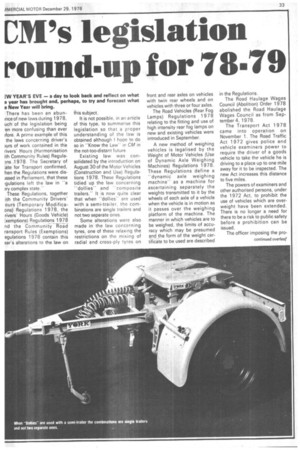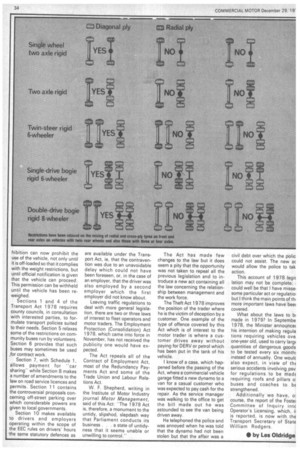ClMrs legislation round-up for 78-79
Page 35

Page 36

If you've noticed an error in this article please click here to report it so we can fix it.
EW YEAR'S EVE — a day to look back and reflect on what a year has brought and, perhaps, to try and forecast what a New Year will bring.
There has been an abunince of new laws during 1978, uch of the legislation being 'en more confusing than ever gore. A prime example of this the laws concerning driver's )urs of work contained in the rivers' Hours (Harmonisation ith Community Rules) Regula)ns .1978. The Secretary of :ate for Transport confirmed, hen the Regulations were disissed in Parliament, that these .gulations left the law in "a my complex state.'"
These Regulations, together ith the Community Drivers' ours (Temporary Modificaons) Regulations 1978, the rivers' Hours (Goods Vehicle) ixemptions) Regulations 1978 nd the Community Rcrad ransport Rules (Exemptions) egulvations 1 978 contain this ear's alterations to the law on
this subject.
It is not possible, in an article of this type, to summarise this legislation so that a proper understanding of the law is obtained although I hope to do so in "Know the Law" in CM in the not-too-distant future.
Existing law was consolidated by the introduction on August 30 of the Motor Vehicles (Construction and Use) Regulations 1978. These Regulations tidied up the law concerning "dollies" and "composite trailers." It is now quite clear that when "dollies" are used with a semi-trailer, the cornbinations are single trailers and not two separate ones.
Some alterations were also made in the law concerning tyres, one of these relaxing the restrictions on the mixing of radial and cross-ply tyres on
front and rear axles on vehicles with twin rear wheels and on vehicles with three or four axles.
The Road Vehicles (Rear Fog Lamps) Regulations 1978 relating to the fitting and use of high intensity rear fog lamps on new and existing vehicles were introduced in September.
A new method of weighing vehicles is legalised by the Weight of Motor Vehicles (Use of Dynamic Axle Weighing 'Machines) Regulations 1978. These Regulations define a "dynamic axle weighing machine" as a machine for ascertaining separately the weights transmitted to it by the wheels of each axle of a vehicle when the vehicle is in motion as it passes over the weighing platform of the machine. The manner in which vehicles are to be weighed, the limits of accuracy which may be presumed and the form of the weight certificate to be used are described in the Regulations.
The Road Haulage Wages Council (Abolition) Order 1978 abolished the Road Haulage Wages Council as from September 4, 1978.
The Transport Act 1 978 came into operation on November 1. The Road Traffic Act 1972 gives police and vehicle examiners power to require the driver of a goods vehicle to take the vehicle he is driving to a place up to one mile away for it to be inspected. The new Act increases this distance to five miles.
The powers of examiners and other authorised persons, under the 1972 Act, to prohibit the use of vehicles which are overweight have been extended. There is no longer a need for there to be a risk to public safety before a prohibition can be issued.
The officer imposing the procontinued overleaf
hibition can now prohibit the use of the vehicle, not only until it is off-loaded so that it complies with the weight restrictions, but until official notification is given that the vehicle can proceed. This permission can be withheld until the vehicle has been reweighed.
Sections 1 and 4 of the Transport Act 1978 requires county councils, in consultation with interested parties, to formulate transport policies suited to their needs. Section 5 relaxes some of the restrictions on community buses run by volunteers. Section 6 provides that such buses may sometimes be used for contract work.
Section 7, with Schedule 1, allows payment for "car sharing" while Section 8 makes a number of amendments to the law on road service licences and permits. Section 11 contains the controversial proposals concerning off-street parking over which considerable powers are given to local governments.
Section 10 makes available to drivers and employers operating within the scope of the EEC rules on drivers' hours the same statutory defences as are available under the Transport Act, ie, that the contravention was due to an unavoidable delay which could not have been foreseen, or, in the case of an employer, that the driver was also employed by a second employer which the first employer did not know about.
Leaving traffic regulations to deal with more general legislation, there are two or three laws of interest to fleet operators and motor traders. The Employment Protection (Consolidation) Act 1978, which came into force in November, has not received the publicity one would have expected.
The Act repeals all of the Contract of Employment Act, most of the Redundancy Payments Act and some of the Trade Union and labour Relations Act.
W. F. Shepherd, writing in the Institute of Motor Industry journal Motor Management, said of this Act: "The 1978 Act is, therefore, a monument to the untidy, slipshod, slapdash way that Parliament conducts its business . . . a state of untidyness that it seems unable or unwilling to control.
The Act has made few changes to the law but it does seem a pity that the opportunity was not taken to repeal all the previous legislation and to introduce a new act containing all the law concerning the relationship between management and the work force.
The Theft Act 1978 improves the position of the trader where he is the victim of deception by a customer. One example of the type of offence covered by this Act which is of interest to the motor trader is where a customer drives away without paying for DERV or petrol which has been put in the tank of his vehicle.
I know of a case, which happened before the passing of the Act, where a commercial vehicle garage fitted a new dynamo to a van for a casual customer who was expected to pay cash for the repair. As the service manager was walking to the office to get the bill made out he was astounded to see the van being driven away.
He telephoned the police and was annoyed when he was told that the dynamo had not been stolen but that the affair was a civil debt over which the polic could not assist. The new ac would allow the police to tak action.
This account of 1978 legi lation may not be complete; could well be that I have miss& some particular act or regulatiol but I think the main points of th more important laws have beei covered.
What about the laws to bi made in 1979? In Septembe 1978, the Minister announce( his intention of making regula tions requiring vehicles ove.
one-year old, used to carry largt quantities of dangerous goods to be tested every six month instead of annually. One woulc also expect, in vieVv of thE serious accidents involving psv for regulations to be mad( requiring roofs and pillars o buses and coaches to bE strengthened.
Additionally we have, ocourse, the report of the Fostei Committee of Inquiry int( Operator's Licensing, which, ii is reported, is now with the Transport Secretary of State William Rodgers.
• by Les Oldridge




































































